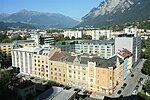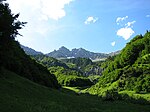University of Innsbruck

The University of Innsbruck (German: Leopold-Franzens-Universität Innsbruck; Latin: Universitas Leopoldino Franciscea) is a public research university in Innsbruck, the capital of the Austrian federal state of Tyrol, founded on October 15, 1669.It is currently the largest education facility in the Austrian Bundesland of Tirol, and the third largest in Austria behind Vienna University and the University of Graz. Significant contributions have been made in many branches, most of all in the physics department. Further, regarding the number of Web of Science-listed publications, it occupies the third rank worldwide in the area of mountain research. In the Handelsblatt Ranking 2015, the business administration faculty ranks among the 15 best business administration faculties in German-speaking countries.
Excerpt from the Wikipedia article University of Innsbruck (License: CC BY-SA 3.0, Authors, Images).University of Innsbruck
Christoph-Probst-Platz, Innsbruck Innenstadt (Innsbruck)
Geographical coordinates (GPS) Address Nearby Places Show on map
Geographical coordinates (GPS)
| Latitude | Longitude |
|---|---|
| N 47.262777777778 ° | E 11.384444444444 ° |
Address
Ehrendenkmal der Universität Innsbruck
Christoph-Probst-Platz
6020 Innsbruck, Innenstadt (Innsbruck)
Tyrol, Austria
Open on Google Maps







